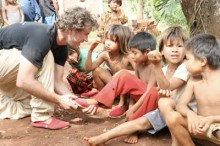
As Internet savvy individuals use social media to change the way they view the world, custom social site provider Ning sits at the epicenter of this shift. Ning has just released a powerful study on social media tools citing that custom designed destination sites that integrate with the best social media tools into a single, seamless community give brands and a companies a huge market advantage to organize, rally, lobby, create or effect change. Ning’s study examines growth and trends in community engagement across the social media ecosystem based on data from nearly 90,000 communities and 65 million unique monthly visitors across the globe.
The Ning Point of View shines a light on the actions of its Ning community creators and participants and also ranks the most social categories and regions online. The report showed that education outranks music and politics to secure the number one spot, while California, New York and Texas rank as the top social states on the web. Other findings from the report include the fact that it only takes 20 people to bring an online community to a significant level of activity and connectivity and that there is a shift from broadcasting status updates to developing dialog, highlighting the importance of two-way conversation in social media.
We caught up with Ning’s CEO Jason Rosenthal to discuss the data and trends emerging in the custom social web ecosystem.
CBM: What is Ning? How did you become its CEO?
Jason Rosenthal: I’ve been at Ning for almost three years. Before becoming the CEO in March, I was the COO. Ning is the world’s largest platform for creating social websites. There are 130 million static websites out there and our mission is to make it easy for them to be become social, mobile and more powerful. To date, we have over 90,000 Ning communities and 65 million unique users globally every month.
CBM: How do you define the “social media ecosystem”? Is it a healthy ecosystem?
 JR: The notion of word-of-mouth, review, comments, etc. has been around for decades. What social media has enabled is the ability to surface and invite organic conversations in a scalable manner. It gives consumers the power, the tools, and the podium to voice their opinions like never before.
JR: The notion of word-of-mouth, review, comments, etc. has been around for decades. What social media has enabled is the ability to surface and invite organic conversations in a scalable manner. It gives consumers the power, the tools, and the podium to voice their opinions like never before.
The social media ecosystem is comprised of 3 key elements:
- Consumers who generate content organically – comments, reviews, blogs, photos, video, etc.
- Businesses that provide products and services that are the objects that consumers talk about
- Social Media Platforms that are the enabler of social interactions
Social media is extremely powerful and levels the playing field for all businesses – big or small – to be able to get the word out without a huge advertising budget. Businesses have an opportunity to take a more proactive position when it comes to social by:
- Taking full advantage of social traffic to drive towards their bottom line by owning the data.
- Realizing that social media is just a channel. Use social media to promote their own brand instead of other people’s brand.
- Understanding that having 1,000 “friends” doesn’t mean you have 1,000 ambassadors for your product. You need to do the work to take them to the next level.
CBM: California and New York I get, but what’s going on in Texas?
JR: You may be surprised by what Texas has to offer. There is no shortage of innovations in Texas. Manor Texas, a small town in Texas where 6,500 people reside, is the home for Manor Labs which is one of the most innovative organizations that conducts research and development on new, emerging technologies to better serve its residents and anyone is welcome to participate.
CBM: Facebook and Twitter are tied. When do you think that will change and when it does who do you think will pull ahead?
JR: I think Facebook and Twitter play rather different roles in the social space. Twitter is a real-time information engine where authority matters while Facebook is centered on connecting with friends and family. So I don’t see that as a zero-sum game.
CBM: Have you seen our piece on How the Internet is Revolutionizing Education? How do you think social media will have a positive impact on education?
JR: Yes. Some of the comments caught my eye as some of the academics have the perception that online education is passive. One of the most popular categories on Ning is education. Social media changes how online education can be done – instead of one-way teaching where the student just hits the play button, it brings in the many-to-many interactions that you get in physical classrooms. Educators and students can go beyond the geographic limits, connect with other people around the world interested in the same topic, and benefit from a broader perspective.
CBM: Why is gaming so hot right now?
JR: We are all social animals. What social gaming does is it gives people yet another way to engage together on something common. Gaming at its core is action and reward. By participating in social games, we get status, rewards and have fun. We use those principles in thinking about how people engage in social experiences.
 CBM: And finally, who are the 3 most socially savvy brands?
CBM: And finally, who are the 3 most socially savvy brands?
JR: It’s really interesting to see how some of the biggest companies reinvigorate their brands with social such as Old Spice and Volkswagen. I also admire how TOMS Shoes (who happens to be one of our customers) has enabled customers to be their evangelists to get the word out for their cause.
Get the TNW newsletter
Get the most important tech news in your inbox each week.




